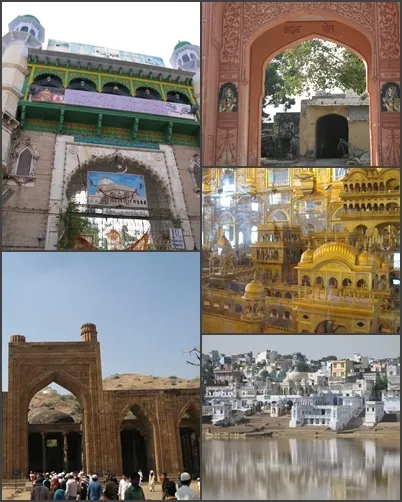Ajmer-Pushkar

Early in the morning, we arrived in Jaipur from Jaisalmer by train. Our hotel’s cab driver, who had been arranged in advance, was waiting for us, and we took a moment to relax at the hotel upon arrival. Before departing for Jodhpur, we had pre-arranged a trip to Ajmer-Pushkar with our reliable cab driver, Mr. Singh. As expected, he was punctual, and we left the hotel around 8:00 am. We enjoyed breakfast at a small, tidy dhaba on the way. The six-lane road made for a comfortable and uncrowded journey.
Our first stop was Kishangarh fort, featuring Phool Mahal Palace, a heritage hotel located alongside Gundalao Lake. This heritage hotel was formerly the residence of the Maharajas of Kishangarh. A significant portion of the lake bed has been transformed into lush fields. The area is well-known for its miniature paintings, but due to the holiday, we couldn’t visit any art galleries. We took a few photographs and headed to our next destination.
Soniji Ki Nasiyan in Ajmer is a Digambar Jain temple. The main chamber, known as the Swarna Nagari (City of Gold), houses several gold-plated wooden figures that depict characters from Jain tradition. The main prayer hall is a separate complex.
From there, we proceeded to the Dargah Sharif of Khwaja Moinuddin Chisti. Because it was Diwali and a Friday, the shrine was extremely crowded. We had to leave our camera and shoes outside with a flower vendor, and wearing head coverings was mandatory. After paying our respects, we inquired about the location of Adhai Din Ka Jhopda, a Vaishnav Hindu temple built in 1153 and later converted into a mosque by Qutubudin Aybak in 1193. We walked there through narrow lanes filled with small eateries and sweet shops. If you’re particular about hygiene, you might want to skip this part of Ajmer.
Mr. Singh then took us to Anasagar Lake, a man-made lake where we could relax and take a break. It was truly refreshing and provided a respite after the crowded and bustling experience around the Dargah.

Ajmer and Pushkar are located on opposite sides of a common mountain range, and the distance between them is only 15 km. Our first stop in Pushkar was the Brahma temple (the creator of the universe). An interesting aspect of Hindu mythology is that Lord Brahma is exclusively worshiped in Pushkar throughout the universe because he was cursed by his first wife. There are two temples dedicated to his two wives atop two separate mountain peaks, with his own temple situated next to Pushkar Lake. Unlike the Dargah, there were hardly any crowds here.
Finally, we visited Pushkar Lake, where all the houses next to the lake are painted in blue to symbolize their Brahmin ownership. Just opposite the lake, we found a restaurant where we enjoyed a scrumptious pasta lunch. On our way back, we visited nearby Chota Pushkar, and by early evening, we were back in Jaipur to celebrate Diwali. We took a walk in the residential area near our hotel and had dinner. This was Aarush’s first-hand experience of Diwali in North India, where the sounds of firecrackers are louder compared to the South.
About the Author

Pamela
View all posts →

